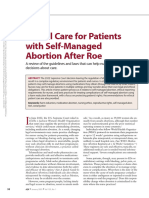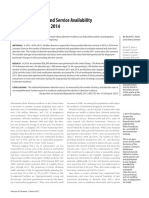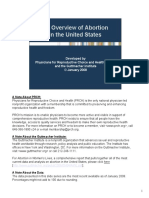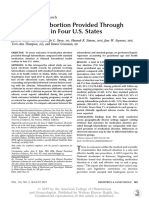#WeCount report, April 2022 to December 2024
Released: June 23, 2025
#WeCount is a time-limited reporting effort that aims to capture national shifts in
abortion volume, by state and month, following the Dobbs v Jackson Women’s Health
Organization Supreme Court decision to overturn Roe v Wade. This report includes
data from April 2022 to December 2024.
For media inquiries, please contact SFP@ConwayStrategic.com.
For questions about #WeCount and information on how to enroll your practice, please
contact WeCount@SocietyFP.org.
Please use the citation below to cite this #WeCount report.
Society of Family Planning. #WeCount Report April 2022 through December
2024. 23 Jun. 2025, https://societyfp.org/wecount-report-9-december-2024-data/,
https://doi.org/10.46621/725961gzsnai.
Key findings
• The total number of abortions was higher in 2024 than it was in 2023 or 2022.
• The majority of abortions occurred in-person.
• The number of abortions delivered via telehealth has continued to increase
since April 2022, when #WeCount became the first national study to track
telehealth.
• By the end of 2024, 1 in 4 abortions was provided via telehealth.
• Shield laws continue to facilitate the receipt of medication abortion, with an
average of 12,330 abortions per month provided under shield laws by the end of
2024.
• Drivers of these trends are unclear, especially in the context of multiple changes
in the service delivery environment; new evidence that helps contextualize these
findings continues to emerge.
Page 1 of 17
�National findings
Total abortions in the US have increased since Dobbs
The monthly number of abortions increased gradually over time in the US since 2022.
Page 2 of 17
�US abortions totaled 1.14 million in 2024
In 2024, 1.14 million abortions occurred in the US, the largest number of abortions in the US in recent years. The monthly
total peaked in January 2024, reaching over 102,000 abortions in a single month.
Page 3 of 17
�Monthly average number of abortions increased each year
The monthly average number of abortions climbed from around 80,000 in 2022, to 88,000 in 2023, to 95,000 in 2024.
Note that the 2022 monthly average is less precise because it reflects only April to December of that year; we did not
collect data in January to March, which, in subsequent years, had higher volume of abortions. In addition, these months
were pre-Dobbs, before abortion bans were enacted.
Page 4 of 17
�The monthly number of abortions increased each year
Comparisons of year over year show that for most months the number of abortions in 2024 was higher than the number of
abortions in the same month of 2023 or 2022.
Page 5 of 17
�Telehealth findings
By Q4 of 2024, 1 in 4 abortions were provided via telehealth
The proportion of abortions that were provided via telehealth increased over time from 5% in April-June of 2022 to 25% by
the end of December 2024.
Page 6 of 17
�In-person abortion care declined slightly, while telehealth grew
Telehealth abortion care (which involves mailing medication abortion pills) increased both in proportion and in absolute
numbers over the study period. In-person abortion care (which includes both procedural abortions and medication
abortion pills dispensed in person), was much more common than telehealth abortions. As telehealth has grown, the
number of in-person abortions has not declined commensurately. The number of in-person abortions was lower in the
second half of each year compared to the first half.
Page 7 of 17
�The majority of abortions still take place in-person
In the US, in-person provision continues to represent the majority of abortion care.
Page 8 of 17
�The proportion of abortions provided via telehealth varied by state, 2024
Across the US, in states that permit abortion and telehealth provision of abortion, there is substantial variation in the
proportion of abortions provided via telehealth, ranging from 7% to 40%. In several larger states, telehealth is a smaller
share of the abortions, at about 9-12% of all abortions.
Page 9 of 17
�Abortions provided by virtual-only clinics have increased since Dobbs
Virtual clinics (those that that are online only and have no brick-and mortar clinic) in states that permit abortion and
telehealth abortion have provided an increasing number of abortions since 2022.
Page 10 of 17
�Abortions provided under shield laws have increased since this route to care became available
Providing abortions under shield laws involves mailing medication abortion pills to people in states with telehealth
restrictions, 6-week bans, or total abortion bans. The number of abortions provided under shield laws has increased since
providers began to offer abortion under shield laws in July 2023, with notable increases in provision to states with 6-week
bans and total abortion bans. Some of the increase into states with 6-week bans is due to the states switching categories,
when the states transitioned from having telehealth restrictions to having 6-week bans during this time period. By
December 2024, abortions provided under shield laws totaled nearly 14,000 that month.
Page 11 of 17
�Legal climates appear to play an important role in telehealth use
Telehealth abortions provided by virtual clinics (those that that are online only and have no brick-and mortar clinic) to
states that permit abortion and telehealth abortion have increased since 2023. Telehealth abortions provided by brick-and-
mortar clinics have remained steady. Telehealth abortions provided into states with telehealth restrictions also remained
relatively steady. Telehealth abortions provided into states with 6-week bans have increased; some of the increase into
states with 6-week bans was due to the states switching from having telehealth restrictions to having 6-week bans during
this time period. Telehealth abortions provided into states with total bans increased substantially by the end of 2024.
Page 12 of 17
�Half of abortions provided via telehealth in 2024 were facilitated by shield laws
Disaggregating in-person and telehealth and summing up across states by legal climate in 2024, there were stark
differences in mode of provision, with a larger proportion of abortions provided by telehealth with each restrictiveness
category. In states where abortion and telehealth were permitted, on average, 15% of abortions were provided via
telehealth each month. In states where abortion was permitted but telehealth was restricted, on average 16% of abortions
were provided via telehealth each month. In states with 6-week bans, on average 28% of abortions were provided via
telehealth each month. In states where abortion was totally banned, there was a monthly average of only 30 abortions
provided in-person, under so-called exceptions, and over 99% of abortions were provided by telehealth. In 2024, the
monthly average number of abortions provided under shield laws was about 10,000 per month. Abortions provided under
shield laws accounted for 49% of all abortion provided via telehealth in 2024.
Page 13 of 17
�Background
#WeCount is a national effort that aims to report the monthly number of abortions in the
US, by state and month starting in April 2022. #WeCount data include clinician-provided
abortions, defined in this report as medication or procedural abortions completed by a
licensed clinician within the US in a clinic, private medical office, hospital, or virtual-only
clinic. This report does not reflect any self-managed abortions, defined as ending a
pregnancy outside the formal healthcare system. These data reflect the status of
abortion provision in the US and can be used by healthcare systems, public health
practitioners, and policymakers so that their decisions can be informed by evidence.
Terminology
Delivery settings
• Brick and mortar clinic: A physical clinic where a patient can go to receive care
• Virtual-only clinic: An online-only provider
Delivery methods
• Brick-and-mortar telehealth: Telehealth abortions offered by a brick-and-mortar
clinic
• In-person care: Abortions in which a clinician meets with the patient face-to-
face; can be procedural or medication abortions
• Self-managed abortion: Abortion using medications, herbs, or something else,
or obtaining pills from friends or online without clinician assistance
• Telehealth abortion: Medication abortion offered by a clinician through remote
consultation with the patient, resulting in remote dispensing of medications by
mail
Types of care
• Medication abortion: Abortion performed with medications, including
mifepristone, misoprostol, and misoprostol alone
• Procedural abortion: Abortion performed with instrumentation, including uterine
aspiration (manual or electric), dilation and curettage, dilation and evacuation, or
dilation and extraction
Legal context
• Shield laws: Legal protections put in place by some states to reduce legal risk
for clinicians who offer abortions to patients in states where abortion is prohibited
or severely restricted
Methods
In early 2022, #WeCount developed a database of all clinics, private medical offices,
hospitals, and virtual clinic providers in the US known to offer abortion care. We started
with the Abortion Facility Database from Advancing New Standards in Reproductive
Page 14 of 17
�Health (ANSIRH) at University of California, San Francisco. Throughout the study
period, we added new providers to our database as we became aware of them,
using AbortionFinder.org and INeedanA.com to conduct regular searches in all 50
states and the District of Columbia. This report also includes abortions provided under
shield laws by US-based licensed providers who are following their own state law. The
Society provided compensation to participating facilities for each monthly submission.
The data in this report includes the monthly counts reported by providers for April 2022
through December 2024. In total, 83% of the abortions across the study period were
based on data obtained from providers or health departments, while the remaining 17%
of the data were imputed. The magnitude of imputation in each state is noted with
symbols in the data tables. In 18 states, all known providers reported to #WeCount; we
imputed any months not reported by these providers. For these imputations, we
calculated the average percent change in abortion volume in the state and imputed
values for providers with missing months. In the remaining 33 states and Washington,
DC, some providers never reported to #WeCount; for these providers we imputed all
months of data. To develop our imputations, we used information from news articles,
contacts known to the non-reporting clinics, knowledge of the abortion volumes by state,
or the median #WeCount number for the clinic or hospital type. To compute medians,
we categorized reporters to #WeCount into five types of facilities and calculated the
median for April and May 2022 for each category: 1) small abortion clinics, 2) large
abortion clinics, 3) primary care clinics, 4) low volume hospitals, and 5) high volume
hospitals. In ten states we also used publicly available state administrative data to
supplement our estimates. We developed separate imputations for virtual clinics that did
not submit data to us, using the median number of abortions that were provided by
other virtual clinics in the state.
We reported the number of abortions by state and by restrictiveness level using three
categories: states that banned abortion, states that restricted abortion to before
detection of embryonic cardiac activity, also referred to as a “6-week bans” because
detection of such activity usually occurs around that point, and states that permitted
abortion. These categories were based on the abortion policy in each state on the 15th
of each month as reported by the New York Times. For a legal analysis of restrictions
that prevent explicitly ban telehealth or implicitly preclude telehealth abortion, we rely on
the RHITES map. Monthly state totals were rounded to the nearest 10.
#WeCount was deemed exempt by Advarra IRB. All major decisions were guided by a
Research Steering Committee listed below. This research was sponsored by the
Society of Family Planning.
Limitations
Counts are an underrepresentation of all abortions in the US. #WeCount has a
comprehensive count of abortions provided by licensed clinicians, with more than 83%
of all abortions reported and about 17% imputed. Abortions provided by individual
Page 15 of 17
�hospitals and private practice clinicians may be underreported. These counts also do
not include abortions that take place in the US outside of the formal health care system.
We do not have estimates of the proportion of people who did not take the
medications sent to them. These data show telehealth abortions as the providers
documented mailing them. Some people may not have taken the pills, and we do not
have an estimate of that. Use of shield laws to provide abortion via telehealth into states
with total or 6-week abortion bans or with telehealth abortion restrictions started in July
2023, and #WeCount began to count abortions provided under shield laws at that time.
Because of this transition in abortion provision, #WeCount does not have a comparator
for previous months.
#WeCount cannot estimate the unmet needs for abortion. Research has yet to
accurately capture the underlying need for abortion. We don't have any counts of the
number of people who needed an abortion and didn't get it.
#WeCount is designed to describe changes in abortion access and provision, rather
than to explain why these changes are taking place.
Contributors
#WeCount is made possible by the many abortion providers who generously reported
their data in support of this effort. This report was prepared by the #WeCount Co-Chairs
and Society of Family Planning staff, with guidance from the Research Steering
Committee, as well as many members of the Society of Family Planning community.
#WeCount Co-Chairs
• Alison Norris, MD, PhD; Ohio State University
• Ushma Upadhyay, PhD, MPH; University of California, San Francisco
#WeCount Research Steering Committee
• Abigail Aiken, MD, PhD, MPH; University of Texas at Austin
• Danielle Bessett, PhD, MA; University of Cincinnati
• Anitra Beasley, MD, MPH; Baylor College of Medicine
• Angel Foster, DPhil, MD, AM; University of Ottawa
• Jenny Higgins, PhD, MPH; University of Wisconsin
• Rachel Jones, PhD; Guttmacher Institute
• Isaac Maddow-Zimet, MS; Guttmacher Institute
• Caitlin Myers, PhD; Middlebury College
• Whitney Rice, DrPH, MPH; Emory University
• Hannah Simons, DrPH; Planned Parenthood Federation of America
• Mikaela Smith, PhD; Ohio State University
• Terri-Ann Thompson, PhD; Ibis Reproductive Health
• Kari White, PhD, MPH; Resound Research for Reproductive Health
#WeCount Society of Family Planning staff
Page 16 of 17
�• Jenny O’Donnell, ScD, MS; Vice President of Research and Evaluation
• Claire Yuan, MPP; #WeCount Data Manager
Page 17 of 17



















































































































